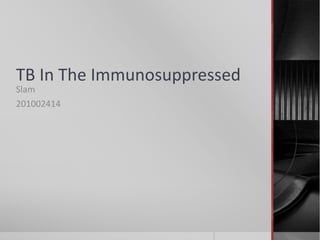Tb in the immunosuppressed
- 1. TB In The Immunosuppressed Slam 201002414
- 3. Introduction ï§ TB is the most common opportunistic infection ï§ By producing a progressive decline in cell-mediated immunity, ï§ HIV alters the pathogenesis of TB, ï§ greatly increasing the risk of disease from TB in HIV-co-infected individuals ï§ and leading to more frequent extra-pulmonary involvement, ï§ atypical radiographic manifestations, ï§ and paucibacillary disease, which can impede timely diagnosis
- 4. ï§ In HIV-infected patients with LTBI, active TB develops in about 5 to 10%/yr, whereas in people who are not immunocompromised, it develops in about the same percentage over a lifetime ï§ a chest x-ray may show a nonspecific pneumonia or even be normal. ï§ Smear-negative TB is more common when HIV coinfection is present. ï§ Because smear-negative TB is common, HIV-TB coinfection is often considered a paucibacillary disease state.
- 5. Immunity
- 6. Impact of HIV Infection on the Pathogenesis of Tuberculosis ï§ Defective macrophages function in response to TB infection ï§ HIV impairs the host's ability to contain new TB infection ï§ etc
- 8. ï§ The presentation of TB also is affected by the extent of HIV-related immunosuppression. ï§ In patients with CD4 counts of >350 cells/ÂĩL, the clinical and radiographic presentation is similar to that of patients without HIV infection. ï§ However, as immunosuppression advances, the radiographic presentation becomes less typical and extra-pulmonary and disseminated disease become more commonâĶ
- 9. Radiographic Findings ï§ Upper-lobe infiltrates and cavities are the typical findings in reactivation TB, whereas intra-thoracic lymphadenopathy and lower-lobe disease are seen in primary TB. ï§ In HIV-infected persons with higher CD4 counts (ie, >200 cells/ÂĩL), the radiographic pattern tends to be one of reactivation disease with upper-lobe infiltrates with or without cavities. ï§ In HIV-infected persons who have a greater degree of immunosuppression (ie, CD4 count <200 cells/ÂĩL), a pattern of primary disease with intra-thoracic lymphadenopathy and lower-lobe infiltrates is seen. ï§ As chest radiographs may appear normal in up to 21% of those with culture- positive TB and CD4 counts of <50 cells/ÂĩL,(51) a high index of suspicion must be maintained in evaluating an HIV-infected patient with symptoms suggestive of TB
- 12. CD4 Count Significance ï§ In AIDS patients, a mycobacterial illness that develops while the CD4 count is âĨ 200/ΞL is almost always TB. By contrast, depending on the probability of TB exposure, a mycobacterial infection that develops while the CD4 count is < 50/ΞL is usually due to M. avium complex
- 13. MAC


















